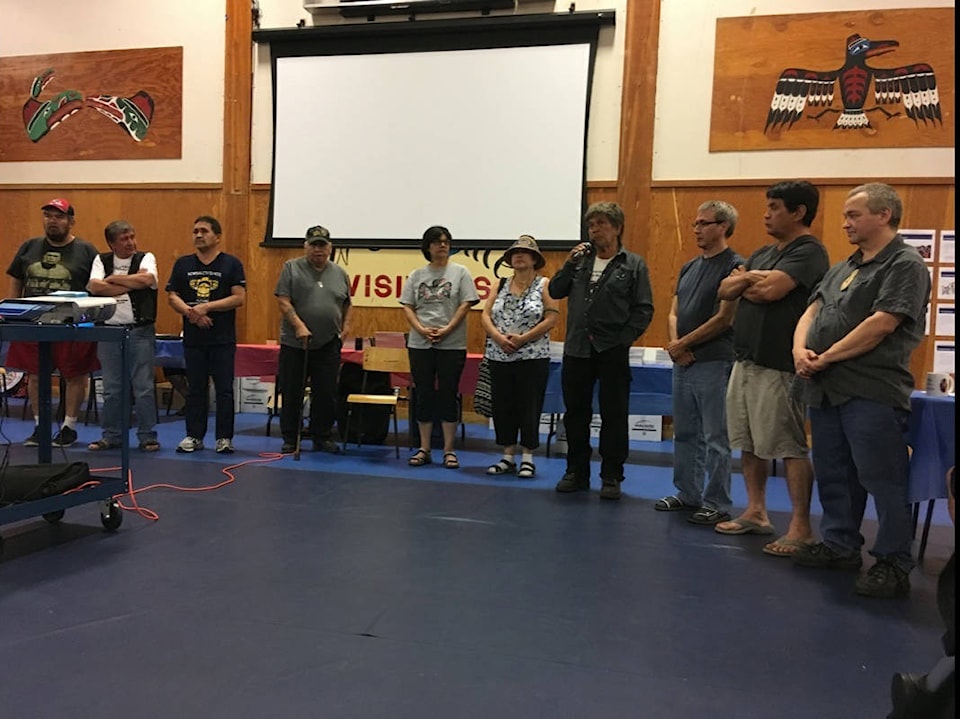A project unique to the Nuxalk Nation was completed last week with the unveiling of “Alhqulh Ti Sputc,” the “Book of Eulachon.” The book had humble beginnings almost four years ago and was initially expected to take only six months.
“It wasn’t exactly a book we were thinking about, it was possibly a stewardship plan because our eulachon are in trouble,” said Nuxalk Stewardship Director Megan Moody. “But as it went along we decided to turn it into more of a book because we wanted to ensure that Nuxalkmc understand everything about eulachon and all our traditional knowledge about eulachon is in one place.”
The last big run of eulachon flowed into the Bella Coola river in 1996. Since then, there have been little to none spotted in the rivers where the little fish were once so plentiful they could be scooped out by the handful.
A generational divide now remains between young and old; there are now children that have grown up in Bella Coola who have never witnessed the coming of the eulachon every spring, the community preparations and the grease making that follows. An unfathomable thought a few decades ago is now reality: young Nuxalkmc don’t know how to make grease.
“More sputc were showing up in nearby rivers about four or five years ago,” said Moody. “2013 was the first time we were actually seeing schools of eulachon in our river since 1998. We got really excited and captured some footage, and we began asking: “When they return in big numbers, how will we teach the next generation about sputc?”
At the same time the federal government was considering listing eulachon as endangered under its Species At Risk Act (SARA). While some may view this as a positive development, the Nuxalk saw it differently.
“This [SARA] could take away the jurisdiction of the Nuxalk people when it comes to managing our eulachon,” Moody explained. “We [the Stewardship Office] started to document all of our stewardship priorities. We wanted to continue to assert our management authority over the eulachon.”
Alkw (speaker) and cultural researcher, Clyde Tallio, who worked closely with Moody on the project, explained that the book has three main objectives.
“Alhqulh Ti Sputc is a foundation for upholding Nuxalk stewardship authority, learning about sputc knowledge and practices, and applying Nuxalk knowledge to restore and protect sputc,” he said. “The main message in the book is that sputc are part of our smayustas; our origins and our inheritance. It is our right and our responsibility to take care of sputc.”
Tallio explained how Nuxalkmc are skilled grease makers, and each family had its own way of making grease. Rules of the river were very strict and enforced by river guardians and the community. Stringent practices were applied to fishing and preparing sputc, and the entire community abided by these rules.
The book opens with an explanation of its purpose and who it is intended for. Nuxalk language is used frequently, as are family’s ancestral names. The smayusta, or creation story of sputc, is carefully documented in both Nuxalk and English and beautifully illustrated by Nuxalk artist Lyle Mack. Traditional knowledge, stories, and detailed explanations of the practice of making grease are described throughout.
“It started as more of a formal research project,” explained coordinator Rachelle Beveridge. “By the end of our initial interviews we began to understand that we needed to do it differently.”
Beveridge said that, with the help of key community members, they held formal and informal interviews, conducted historical research, set up an advisory committee, and went to community events for support.
“We spent a lot of time asking for permissions for images and quotes,” said Beveridge.
What resulted is certainly one of a kind. The book seamlessly blends Nuxalk language, traditional knowledge and ancient practices with issues such as current legislation, management, scientific data, and plans for the future.
Copies of the book were distributed at the feast for Nuxalkmc. The recent closure of Highway 20 meant that only a limited amount were on hand, but more are expected to arrive and will be made available for the community in locations such as the Nuxalk Administration Office.
While the compilation of such important knowledge may be a milestone achievement, Tallio stressed it is not meant to be a replacement of traditional practices, which must be carried on.
“Alhqulh Ti Sputc is just a beginning. Nuxalk knowledge is alive and shared from person to person through cultural practices,” said Tallio. “It can’t be contained in just a book.”
